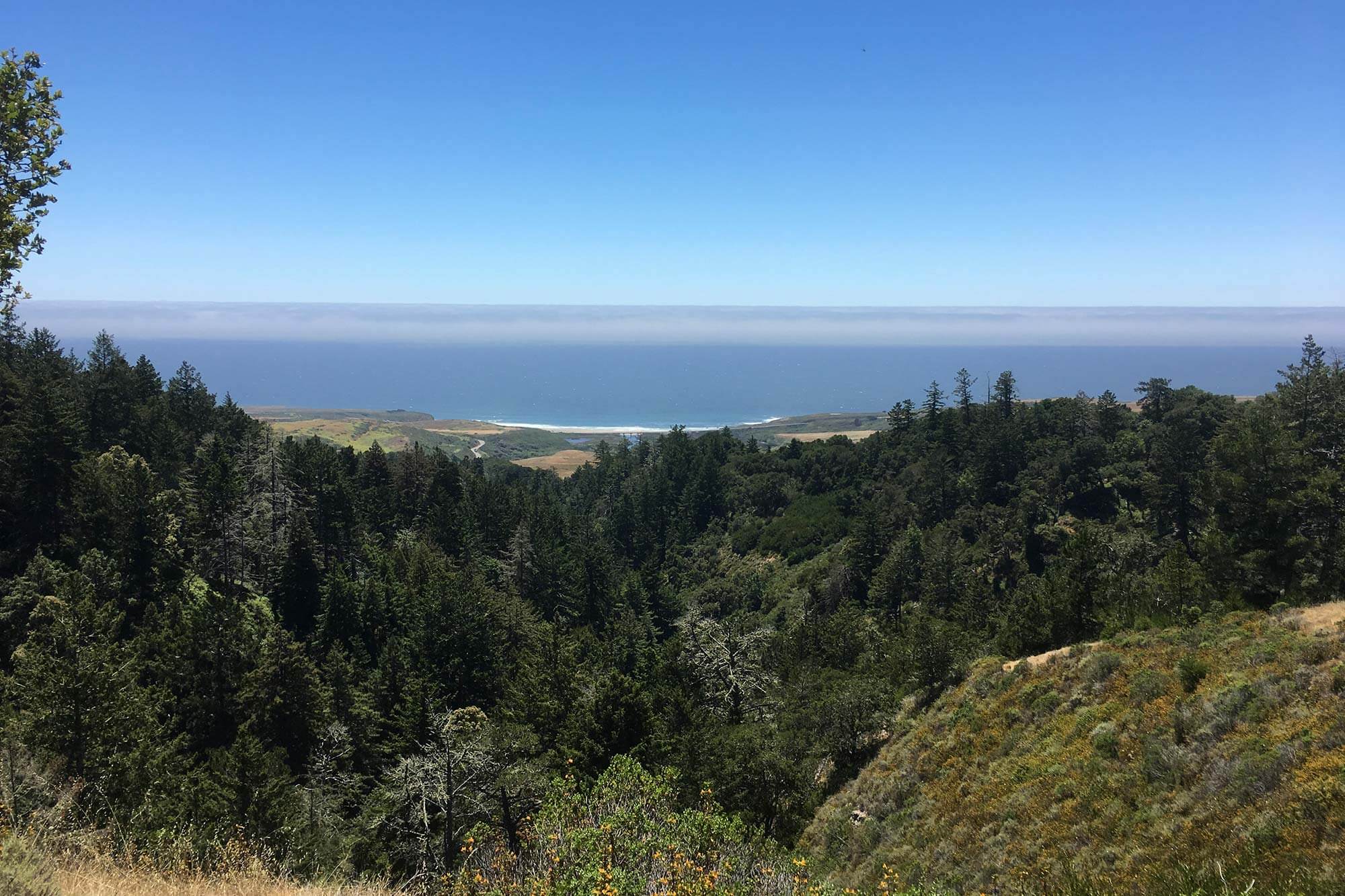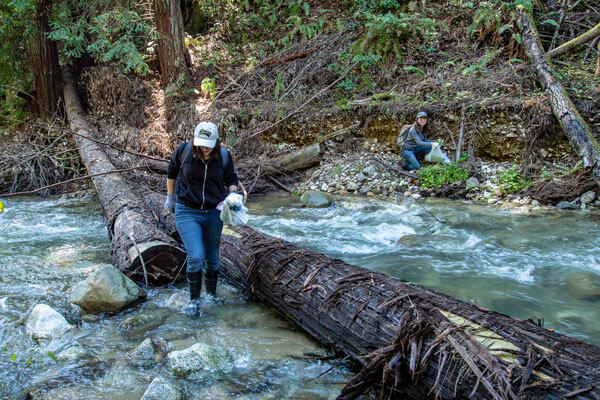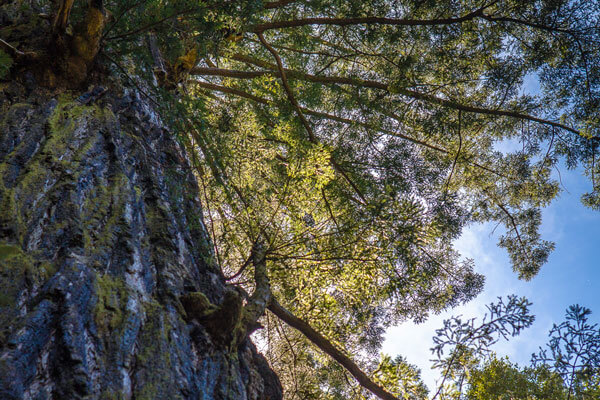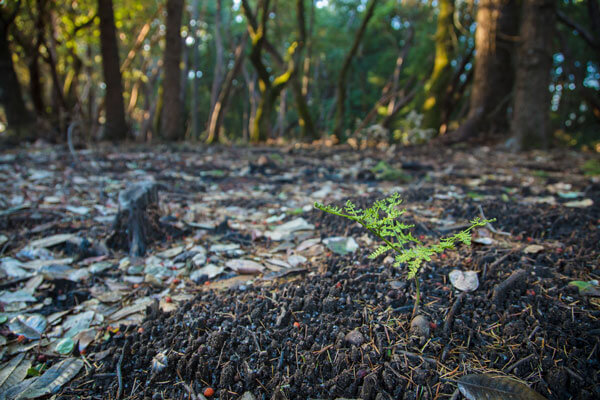photo by Ian Bornarth.
Nurturing Rich Diversity

The Santa Cruz mountains are rich with diverse plant and animal life supported by the different types of microclimates stretching from the summits to the sands. Each microclimate relies on factors such as soils, sun exposure, water, elevation, and temperature. Many of the Santa Cruz mountains’ microclimates contain some of the most rare and threatened habitats in the nation such as old-growth redwood forests, Santa Cruz Sandhills, and coastal prairies. For millennia these lands were tended to by the ancestors of the Amah Mutsun Tribal Band.
Over the last century, preservation of coast redwood forests and their surrounding lands and watersheds in the Santa Cruz mountains has helped safeguard the southern end of the largest temperate rainforest in the world and the countless species of plants and wildlife that need it. Some wildlife require more than one habitat to survive, including rare species like steelhead trout, coho salmon and marbled murrelets that spend much of their life at sea and seek the habitat their reproduction requires in the Santa Cruz mountains.
Read more about wildlife that are protected by preserving land in the Santa Cruz mountains or learn about some of the most interesting plants in each of their habitats and where you might see them. Protecting the lands and water that support such rich and diverse life are a critical first step.
Helping Nature Thrive

Protected land needs ongoing support—stewardship—to help nature thrive. Healthy flora is a major component of thriving habitat helping support the insects and wildlife that rely upon them for food and shelter. Often natural conditions need to be restored to the land after decades of human impacts like logging, damming, roads, and non-native plants that harm or overwhelm the native flora. Removing invasive plants brought by people to the Santa Cruz mountains, like old man’s beard that can even choke mighty redwoods, allows native plants to grow and provide habitat.
Releasing the stranglehold on streams such as removing Mill Creek dam at San Vicente Redwoods, not only restores water to plantlife downstream, it re-establishes spawning habitat for species like the endangered coho salmon and threatened steelhead. By returning fallen redwoods to creeks and streams, which were removed by people for over a century, sediment is naturally trapped improving water quality and creating the pools coho salmon and steelhead need to lay their eggs. Steelhead are returning to the area and through wildlife monitoring, including environmental DNA methods, we’ll know when coho salmon return to the pools created by redwood trunks and roots which will be nourished by the coho salmon in exchange.
Water is key for plant life and human implemented water diversions like old culverts often need to be replaced on protected lands to reduce loss of soil and nutrients eroding into the water and decreasing water and habitat quality. Livestock ponds like those at Filice Ranch can be converted back to crucial wetlands for threatened native flora and fauna including California-red-legged frog. Water habitat becomes ever more critical to protect for plants, wildlife, and people as our climate becomes increasingly warmer and drier.
Read more about how we care for the land in the Santa Cruz mountains and the lasting benefits to the ecosystems critical to thriving natural communities.
Guarding Against Climate Change

But ideal conditions are hard to come by. After decades of heavy logging, newer trees can regrow all at once, often too closely together and forced to compete for space, sunlight, and water. The lack of space and resources for the number of trees can leave them stunted and unable to reach their full potential of a healthy forest habitat for other plants and wildlife. By strategically removing stunted trees from groves left overcrowded after past logging, like some at San Vicente Redwoods, and placing them in streams or on the forest floor, we reestablish invaluable habitat while enabling the remaining redwoods in the grove to grow larger canopy habitat, store more carbon from the air, and better utilize resources to weather droughts, fires, and climate change conditions.
Coast redwood trees also play an important role in the water cycle helping to keep the forest cooler and more moist by shading streams so less water evaporates, collecting water from fog and raining it down to the soil and creeks, and even releasing chemicals into the air called terpenes which help condense water in the air to drip down for themselves and the plants around them. Water is crucial for plants, wildlife and people alike. Protecting creeks and the watersheds that feed into them like Butano Creek Watershed is an ever increasing priority in an already drought and fire prone area so that we can conserve as much of the water we all need to thrive as possible and be prepared for wildfire.
Read more about protecting remaining old-growth forests and helping create new old-growth forests, to help ensure a climate-ready future.
Managing For And With Fire
As our climate becomes hotter and drier, our wildfire seasons grow longer and land in the Santa Cruz mountains needs to be managed for and with fire—because not all fire is bad fire.
Fire plays an important role in the ecosystem of the Santa Cruz mountains where many plants are adapted to survive fire. Redwoods are famously fire-adaptive. And some plants called “fire followers” actually rely on an element of fire to seed or sprout. In fact, the years following a wildfire can be an excellent time to see rare native plants flourish.
There is even a long history of fighting fire with fire in the Santa Cruz mountains. Small controlled fires known as “prescribed burns”, like those used by Indigenous Peoples for centuries prior to European contact, not only help native fire adapted plants to propagate, they also clear out built up, dense, and dry plant matter on the ground so there is less fuel to spur on mega-blazes. Stewardship methods like prescribed burns have helped to stave off greater damage from wildfires by reducing the fuel that helps the flames grow taller and spread faster.
But prescribed burns can only be utilized under the right conditions which include the density of the vegetation—too dense, as is common in second-growth forests, and the fire could grow larger than intended—and weather—a hot, windy day could spread the fire further than planned—so prescribed burns haven’t been as widely implemented as perhaps they need to be moving forward.
Areas where wildfire preparedness methods like prescribed burns and strategically placed gaps in vegetation called shaded-fuel breaks have been carried out, like at San Vicente Redwoods, may have protected nearby communities by helping firefighters prevent the spread of flames during the CZU Lightening Complex fire in August 2020. The CZU fire’s unusually high intensity, the worst fire in the Santa Cruz mountains in recorded history, illustrated how climate change has become a climate emergency for the region and its forests. Climate change induced droughts combined with higher temperatures create conditions for hotter, larger wildfires than even the strongest fire adapted flora like mature redwood trees might be able to handle if they happen too frequently for them to recover before major flames strike again. Nature needs time to heal.
It’s clear the future of land protection in the Santa Cruz mountains needs to include managing for and with fire. After the CZU fire touched nearly all of our protected lands, we saw the effect fire preparedness methods had in helping to decrease the intensity of the fire, prevent flames from climbing up to tree canopies, and slow or stop their spread of flames onward. But much more work needs to be done to reintroduce controlled, planned fire to reduce the risk of extreme wildfire throughout the forests of the Santa Cruz mountains to protect our communities and make our forests more resilient to the wildfires and climate changes to come.
Learn more about how we manage lands for and with fire and how we are helping to reimagine Big Basin Redwoods State Park post-fire to honor its past and build it to last.
